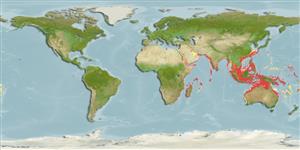Common names from other countries
Environment: milieu / climate zone / depth range / distribution range
Ecología
marino asociado a arrecife; rango de profundidad 20 - 140 m (Ref. 58302). Deep-water; 30°N - 36°S, 22°E - 154°W
Indo-West Pacific: Red Sea and the Persian Gulf eastward to Sri Lanka; then from India to the Philippines and Oahu, Hawaii, north to the Ryukyu Islands (Ref. 559), south to northern Australia. Recently recorded from Reunion (Ref. 53568).
Tamaño / Peso / Age
Maturity: Lm ? range ? - ? cm
Max length : 28.0 cm FL macho / no sexado; (Ref. 3287)
Adults occur in the continental shelf (Ref. 7300). They form schools in depths from 50 to at least 130 m. They feed on epibenthic crustaceans and cephalopods (Ref. 37816). Maximum depth reported taken from Ref. 9773.
Life cycle and mating behavior
Maturities | Reproducción | Spawnings | Egg(s) | Fecundities | Larva
Paxton, J.R., D.F. Hoese, G.R. Allen and J.E. Hanley, 1989. Pisces. Petromyzontidae to Carangidae. Zoological Catalogue of Australia, Vol. 7. Australian Government Publishing Service, Canberra, 665 p. (Ref. 7300)
IUCN Red List Status (Ref. 130435)
CITES (Ref. 128078)
Not Evaluated
Threat to humans
Harmless
Human uses
Pesquerías: escaso valor comercial
Herramientas
Special reports
Download XML
Fuentes de Internet
Estimates based on models
Preferred temperature (Ref.
115969): 22.9 - 28.3, mean 27.2 (based on 781 cells).
Phylogenetic diversity index (Ref.
82804): PD
50 = 0.6250 [Uniqueness, from 0.5 = low to 2.0 = high].
Bayesian length-weight: a=0.01349 (0.00646 - 0.02815), b=2.96 (2.79 - 3.13), in cm Total Length, based on LWR estimates for this (Sub)family-body shape (Ref.
93245).
Nivel trófico (Ref.
69278): 4.1 ±0.48 se; based on food items.
Resiliencia (Ref.
120179): Alto, población duplicada en un tiempo mínimo inferior a 15 meses (Preliminary K or Fecundity.).
Fishing Vulnerability (Ref.
59153): Low vulnerability (21 of 100).
